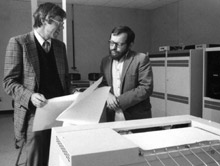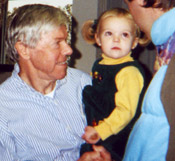
|
Department of Computer Science and Engineering HOME DICK'S ACCOUNT of CSE's early history DIRECTIONS to World Forestry Center, 4033 S.W. Canyon Road, Portland, Oregon, including MAX information. Event is in Cheatham Hall. REGISTER ONLINE
|
|
DICK KIEBURTZ
CSE Department founder and chair 1981-1994 Dick's account of CSE's early history from 20/20 Vision, celebrating the first 20 and next 20 years at OGI |
||
 Dick Kieburtz confers with computer and electronics technician Jerry Boehme in front of the department's first computer, a Digital Equipment VAX 11/780. Introduced in 1978, this “supermini” computer boasted a 1 MIPS processor, 3 Megabytes of main memory and a list price of $200,000. Today you can fit more computing power in the palm of your hand, at about a thousandth the cost. |
President Paul Carlson had assembled a steering committee of industry managers and executives to help OGC launch a new academic department in Computer Science and Engineering. Paul had obtained promises of about one million dollars in startup funding from the captains of local industry. Six hundred thousand of the promised dollars actually materialized as a gift from Tektronix founder Howard Vollum. The initial focus of the department was to be in two areas: Software Engineering and Computer Architecture. By 1981 I was seeking an escape from the paralyzing bureaucracy of SUNY and I accepted the offer to move to Portland and start a new department at OGC. But before leaving Stony Brook, I enticed colleague Dave Maier to bail out with me. The Department opened its doors in September 1981 with an initial suite of 3 or 4 courses per term, taught by myself and adjunct faculty. Most adjuncts came initially from Tektronix Computer Research Labs, which was then a fairly large and thriving organization. Several MS students were admitted the first year, and were supplemented by research students Gene Rollins, Jon Shultis and John Givler who had accompanied me from Stony Brook. These very capable, advanced students were absolutely essential in establishing the credibility of the new department in the OGC environment. The first problem facing the new department was to expand its faculty. Dave Maier would arrive in the fall. Other potential recruits were not so easily convinced that OGC was real. We did find one disgruntled software engineer, eager to resume an academic career. Robbie Babb had been at Boeing long enough to realize it wasn’t actually a software company and he could better pursue his research ideas at OGC. So in the fall of 1982, the faculty grew in size by 200% with the addition of Dave and Robbie. The one-year old department admitted its first PhD students in 1982, Dennis Volpano, Harry Porter and Clifford Walinsky. The Stony Brook PhD students already in residence provided seniority and mentorship to the new students. Course offerings were expanded, as was the adjunct faculty. The first NSF proposals were written and subsequently funded. A regular Friday afternoon CSE colloquium series brought in a mixture of academic and industry speakers from around the country. The Department was actually functioning. A sizable chunk of startup funding was invested in a Digital VAX 780 computer system the first year. A position of computer system administrator, new to OGC, was created and the Department hired iconoclast Bruce Jerrick to fill it. In 1982, Sun Microsystems announced its first networked workstation product, the Sun 1. The Department purchased two. While novel, the Sun 1 was actually an engineering prototype masquerading as a real product, but I had one on my desk for several years. During the next several years, the department had some success in recruiting new faculty. Dick Hamlet joined and we had a real software engineer. Dan Hammerstrom joined and we had a real computer architect. In 1985, we moved into a building of our own. CSE awarded its first PhD degree in 1986. However, the prospects for continued growth of the Department were uncertain. After exhausting the initial funding, CSE reached a financial equilibrium in which it met its budget each year, but didn’t generate surpluses to fund the startup of additional faculty. Industry leaders spoke of OGC as being “too small” to achieve national stature or supply a significant number of graduates. OGC’s adventure into commercial real estate left the institute with insufficient capital to invest in growth. Representing Oregon’s First Congressional District at the time was visionary Congressman Les AuCoin, who saw the expanding importance of high-tech industry in the economy of his district, and believed OGC could provide research and advanced educational opportunity to complement it. Furthemore, Congressman AuCoin was well-placed to help, as the Chair of the Defense Appropriations Subcommittee. AuCoin, and his counterpart in the Senate, Mark Hatfield, steered a 5-million-dollar appropriation to OGC in 1987 to fund research in computing technology. Although the state’s higher education system, late to realize that a potential opportunity had passed it by, made a grab at the funds, their attempt was deflected. I was confident that CSE had the investment it needed to move to the next level. |
|
 Kieburtz and his granddaughter join CSE faculty, staff and students to celebrate the announcement of his ACM Fellow honor in June 2001. |
||
| |
||

